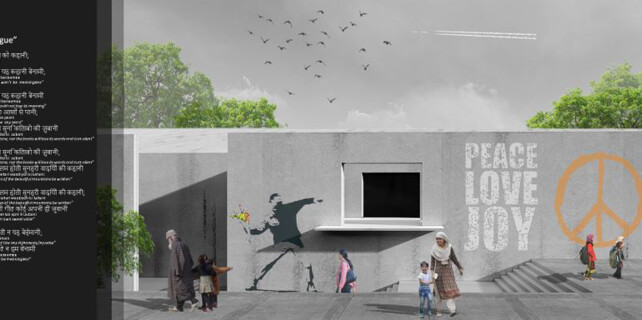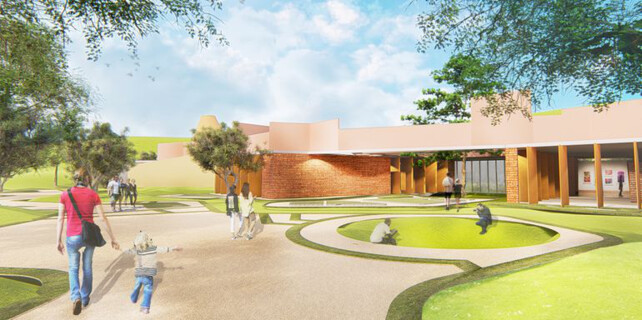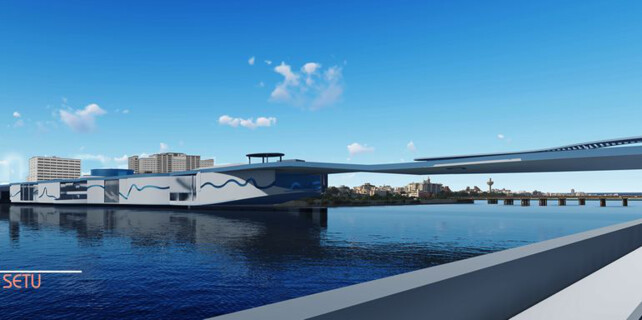- wa-ID
- wa-2027365
- Tag der Veröffentlichung
- 02.09.2019
- Aktualisiert am
- 09.06.2020
- Verfahrensart
- Offener Wettbewerb
- Zulassungsbereich
-
Andere
- Teilnehmer
- Keine Teilnahmebeschränkung
- Auslober
- UNI - UNIEGIS NETWORK Private Limited
- Bewerbungsschluss
- 03.02.2020
- Abgabetermin
- 04.02.2020
- Preisgerichtssitzung
- 25.02.2020
- Preisgerichtssitzung
- 25.02.-24.04.2020
- Bekanntgabe
- 07.05.2020
Verfahrensart
Offener Ideenwettbewerb
Wettbewerbsaufgabe
Unter der Regierung von Jawaharlal Nehru (Indiens erstem Premierminister) wurden in Indien verschiedene neue Akademien gegründet und denkmalgeschützte Gebäude mit kulturellen Einrichtungen nachgerüstet. Dies geschah, um Kunst und traditionelles Handwerk ins städtische Rampenlicht zu rücken. Nach seinem Tod wurde die Vision von den kommenden Regierungen in den 1970er Jahren vorangetrieben.
Es wurde ein neuer Entwurf ausgearbeitet, in dem die Notwendigkeit einer kulturellen Wiederbelebung und der Erhaltung des immateriellen und materiellen Erbes Indiens betont wurde. Die Absicht bestand darin, Praktizierenden dieser traditionellen Kunstform eine Plattform zu bieten und andere in einem zugänglichen städtischen Forum darüber aufzuklären.
So entstand die Vision des India House oder Bharat Bhavan, das in jedem der 21 Bundesstaaten gebaut werden sollte (1970). Es sollte ein Kulturzentrum sein, das diese Vision durch eine Reihe von Galerien und Ausstellungs-/Aufführungsräumen zum Ausdruck bringt.
Der erste Auftrag für diese Vision ging an den Architekten Charles Correa, dem die Verantwortung für den Entwurf des allerersten Bharat Bhavan in Bhopal (Madhya Pradesh) übertragen wurde. Es bot Raum für zeitgenössischen Ausdruck, Denken, Streben und Innovation für kreative Bestrebungen, die vom ländlichen in den städtischen Raum hineinreichen.
Indien hat nach diesem Gebäude ähnliche öffentliche Einrichtungen und kulturelle Institutionen übernommen; es war jedoch das einzige India House, das gebaut wurde. Der ursprüngliche Plan, in jedem Bundesstaat ein solches Haus zu errichten, wurde nicht verwirklicht.
Wenn wir diese Vision, in der jeder Bundesstaat ein Bharat Bhavan haben könnte, im heutigen Kontext jemals umsetzen könnten, wie würde es dann aussehen? Wie würde sein Entwurf von den neueren Interpretationen und Bestrebungen seines Volkes, seiner Kultur, seines täglichen Lebens sprechen?
Design-Aufgabe: Ein neues Bharat Bhavan im Kontext des Jahres 2020 zu bauen, das Dinge verkörpert, die Indien erschaffen haben und in Indien entstehen. Dieser Gedanke kann sich auf seine Kunstformen, auf Menschen, Kultur, Technologien, Lebensmittel, Techniken, Theater, darstellende Künste, Tanz, Rituale, Film, Musik, bildende Künste und vieles mehr erstrecken.
Competition assignment
Under the leadership of Jawaharlal Nehru (India’s first prime minister), India saw the formation of various new academies and retrofitting of heritage buildings with cultural institutions. This was done to bring arts and traditional crafts in the urban limelight. After his death, the vision was carried forward by the forthcoming governments in the 1970s.
A new draft stating the need for cultural revival and sustaining India’s intangible and tangible heritage was drawn. The intent was to give a platform for practitioners of this traditional art form and educate others about these in an accessible urban forum.
This is how the vision of ‘India House’ or ‘Bharat Bhavan’ was born, envisioned to be built in each of the 21 states (in 1970). It was imagined to be a cultural center that spoke this vision through a series of galleries and exhibition/performance spaces.
The first commission of this vision went to Architect Charles Correa where he was endowed with the responsibility to design the first-ever Bharat Bhavan, in Bhopal (Madhya Pradesh). It provided space for contemporary expression, thought, quest and innovation for creative pursuits grass rooting from the rural to urban areas.
India has embraced similar public venues and cultural institutions after this building; however, this was the only ‘India House‘ built. The original plan of having one in each state did not reach realization.
If we could ever implement this vision where every state could have a Bharat Bhavan in the context of today, how would it be? How would its design speak of the newer interpretations and aspirations of its people, its culture, its daily life?
Design Challenge: To build a new Bharat Bhavan in the context of 2020, encapsulating things that have Made India and are Made in India. This thought can extend to its art forms, to people, culture, technologies, foods, techniques, theatre, performing arts, dance, rituals, film, music, fine arts and a lot more.
Preisgericht / Jury
Ishan Grover Design Director, Karan Grover & Associates, India
Pranab Kishore Das Proprietor, P.K. DAS & ASSOCIATES, India
Jesús Arcos Partner & COO, Aldayjover architecture and Landscape, Spain
Eduardo García Architect, Amas4Arquitectura_Urbanismo, Spain
Offener Ideenwettbewerb
Wettbewerbsaufgabe
Unter der Regierung von Jawaharlal Nehru (Indiens erstem Premierminister) wurden in Indien verschiedene neue Akademien gegründet und denkmalgeschützte Gebäude mit kulturellen Einrichtungen nachgerüstet. Dies geschah, um Kunst und traditionelles Handwerk ins städtische Rampenlicht zu rücken. Nach seinem Tod wurde die Vision von den kommenden Regierungen in den 1970er Jahren vorangetrieben.
Es wurde ein neuer Entwurf ausgearbeitet, in dem die Notwendigkeit einer kulturellen Wiederbelebung und der Erhaltung des immateriellen und materiellen Erbes Indiens betont wurde. Die Absicht bestand darin, Praktizierenden dieser traditionellen Kunstform eine Plattform zu bieten und andere in einem zugänglichen städtischen Forum darüber aufzuklären.
So entstand die Vision des India House oder Bharat Bhavan, das in jedem der 21 Bundesstaaten gebaut werden sollte (1970). Es sollte ein Kulturzentrum sein, das diese Vision durch eine Reihe von Galerien und Ausstellungs-/Aufführungsräumen zum Ausdruck bringt.
Der erste Auftrag für diese Vision ging an den Architekten Charles Correa, dem die Verantwortung für den Entwurf des allerersten Bharat Bhavan in Bhopal (Madhya Pradesh) übertragen wurde. Es bot Raum für zeitgenössischen Ausdruck, Denken, Streben und Innovation für kreative Bestrebungen, die vom ländlichen in den städtischen Raum hineinreichen.
Indien hat nach diesem Gebäude ähnliche öffentliche Einrichtungen und kulturelle Institutionen übernommen; es war jedoch das einzige India House, das gebaut wurde. Der ursprüngliche Plan, in jedem Bundesstaat ein solches Haus zu errichten, wurde nicht verwirklicht.
Wenn wir diese Vision, in der jeder Bundesstaat ein Bharat Bhavan haben könnte, im heutigen Kontext jemals umsetzen könnten, wie würde es dann aussehen? Wie würde sein Entwurf von den neueren Interpretationen und Bestrebungen seines Volkes, seiner Kultur, seines täglichen Lebens sprechen?
Design-Aufgabe: Ein neues Bharat Bhavan im Kontext des Jahres 2020 zu bauen, das Dinge verkörpert, die Indien erschaffen haben und in Indien entstehen. Dieser Gedanke kann sich auf seine Kunstformen, auf Menschen, Kultur, Technologien, Lebensmittel, Techniken, Theater, darstellende Künste, Tanz, Rituale, Film, Musik, bildende Künste und vieles mehr erstrecken.
Competition assignment
Under the leadership of Jawaharlal Nehru (India’s first prime minister), India saw the formation of various new academies and retrofitting of heritage buildings with cultural institutions. This was done to bring arts and traditional crafts in the urban limelight. After his death, the vision was carried forward by the forthcoming governments in the 1970s.
A new draft stating the need for cultural revival and sustaining India’s intangible and tangible heritage was drawn. The intent was to give a platform for practitioners of this traditional art form and educate others about these in an accessible urban forum.
This is how the vision of ‘India House’ or ‘Bharat Bhavan’ was born, envisioned to be built in each of the 21 states (in 1970). It was imagined to be a cultural center that spoke this vision through a series of galleries and exhibition/performance spaces.
The first commission of this vision went to Architect Charles Correa where he was endowed with the responsibility to design the first-ever Bharat Bhavan, in Bhopal (Madhya Pradesh). It provided space for contemporary expression, thought, quest and innovation for creative pursuits grass rooting from the rural to urban areas.
India has embraced similar public venues and cultural institutions after this building; however, this was the only ‘India House‘ built. The original plan of having one in each state did not reach realization.
If we could ever implement this vision where every state could have a Bharat Bhavan in the context of today, how would it be? How would its design speak of the newer interpretations and aspirations of its people, its culture, its daily life?
Design Challenge: To build a new Bharat Bhavan in the context of 2020, encapsulating things that have Made India and are Made in India. This thought can extend to its art forms, to people, culture, technologies, foods, techniques, theatre, performing arts, dance, rituals, film, music, fine arts and a lot more.
Preisgericht / Jury
Ishan Grover Design Director, Karan Grover & Associates, India
Pranab Kishore Das Proprietor, P.K. DAS & ASSOCIATES, India
Jesús Arcos Partner & COO, Aldayjover architecture and Landscape, Spain
Eduardo García Architect, Amas4Arquitectura_Urbanismo, Spain
Bharat Bhavan 2020
Organizers
UNI, UNIEGIS NETWORK Private Limited, New Delhi
competitions.uni.xyz
Overview
Under the leadership of Jawaharlal Nehru (India’s first prime minister), India saw the formation of various new academies and retrofitting of heritage buildings with cultural institutions. This was done to bring arts and traditional crafts in the urban limelight. After his death, the vision was carried forward by the forthcoming governments in the 1970s.
A new draft stating the need for cultural revival and sustaining India’s intangible and tangible heritage was drawn. The intent was to give a platform for practitioners of this traditional art form and educate others about these in an accessible urban forum.
This is how the vision of ‘India House’ or ‘Bharat Bhavan’ was born, envisioned to be built in each of the 21 states (in 1970). It was imagined to be a cultural center that spoke this vision through a series of galleries and exhibition/performance spaces.
Challenge
The first commission of this vision went to Architect Charles Correa where he was endowed with the responsibility to design the first-ever Bharat Bhavan, in Bhopal (Madhya Pradesh). It provided space for contemporary expression, thought, quest and innovation for creative pursuits grass rooting from the rural to urban areas.
India has embraced similar public venues and cultural institutions after this building; however, this was the only ‘India House‘ built. The original plan of having one in each state did not reach realization.
If we could ever implement this vision where every state could have a Bharat Bhavan in the context of today, how would it be? How would its design speak of the newer interpretations and aspirations of its people, its culture, its daily life?
Design Challenge: To build a new Bharat Bhavan in the context of 2020, encapsulating things that have Made India and are Made in India. This thought can extend to its art forms, to people, culture, technologies, foods, techniques, theatre, performing arts, dance, rituals, film, music, fine arts and a lot more.
Competition Type
Open ideas competition
Admission Area
International
Eligibility
Minimum eligible age for participation is 18 years.
There is no restriction to the degree or design disciplines to participate in the challenge.
Participation in the competition can happen in a team as well as an individual.
Maximum numbers of participants in a team are 4.
The challenge is open worldwide for anyone to participate.
Schedule
Registration ends: January 07, 2020
Submission ends: January 17, 2020
Shortlist entries announced: January 27, 2020
Jury evaluation: January 27 – February 16, 2020
Public voting ends: February 16, 2020
Results announcement: February 26, 2020
More information and documents at
competitions.uni.xyz/bharat-bhavan-2020
Organizers
UNI, UNIEGIS NETWORK Private Limited, New Delhi
competitions.uni.xyz
Overview
Under the leadership of Jawaharlal Nehru (India’s first prime minister), India saw the formation of various new academies and retrofitting of heritage buildings with cultural institutions. This was done to bring arts and traditional crafts in the urban limelight. After his death, the vision was carried forward by the forthcoming governments in the 1970s.
A new draft stating the need for cultural revival and sustaining India’s intangible and tangible heritage was drawn. The intent was to give a platform for practitioners of this traditional art form and educate others about these in an accessible urban forum.
This is how the vision of ‘India House’ or ‘Bharat Bhavan’ was born, envisioned to be built in each of the 21 states (in 1970). It was imagined to be a cultural center that spoke this vision through a series of galleries and exhibition/performance spaces.
Challenge
The first commission of this vision went to Architect Charles Correa where he was endowed with the responsibility to design the first-ever Bharat Bhavan, in Bhopal (Madhya Pradesh). It provided space for contemporary expression, thought, quest and innovation for creative pursuits grass rooting from the rural to urban areas.
India has embraced similar public venues and cultural institutions after this building; however, this was the only ‘India House‘ built. The original plan of having one in each state did not reach realization.
If we could ever implement this vision where every state could have a Bharat Bhavan in the context of today, how would it be? How would its design speak of the newer interpretations and aspirations of its people, its culture, its daily life?
Design Challenge: To build a new Bharat Bhavan in the context of 2020, encapsulating things that have Made India and are Made in India. This thought can extend to its art forms, to people, culture, technologies, foods, techniques, theatre, performing arts, dance, rituals, film, music, fine arts and a lot more.
Competition Type
Open ideas competition
Admission Area
International
Eligibility
Minimum eligible age for participation is 18 years.
There is no restriction to the degree or design disciplines to participate in the challenge.
Participation in the competition can happen in a team as well as an individual.
Maximum numbers of participants in a team are 4.
The challenge is open worldwide for anyone to participate.
Schedule
Registration ends: January 07, 2020
Submission ends: January 17, 2020
Shortlist entries announced: January 27, 2020
Jury evaluation: January 27 – February 16, 2020
Public voting ends: February 16, 2020
Results announcement: February 26, 2020
More information and documents at
competitions.uni.xyz/bharat-bhavan-2020









